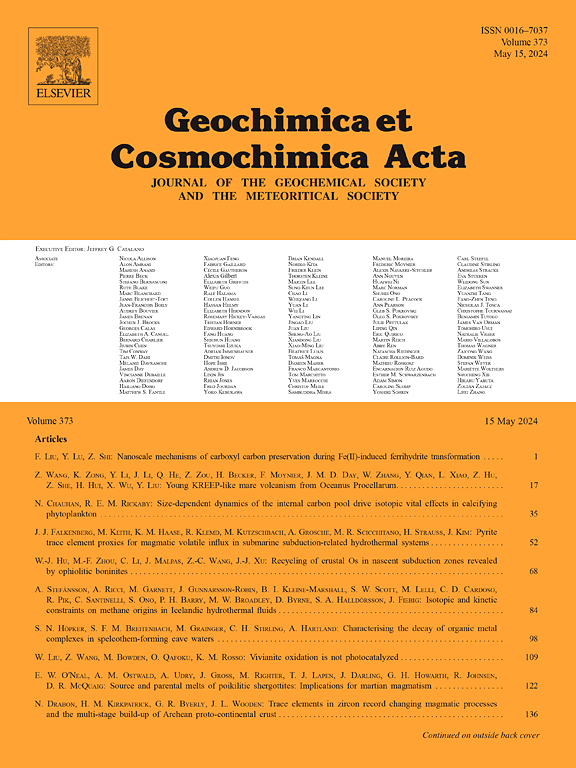Coupled feldspar dissolution and secondary mineral precipitation in batch systems: 6. Labradorite dissolution, calcite growth, and clay precipitation at 60 °C and pH 8.2–8.4
IF 4.5
1区 地球科学
Q1 GEOCHEMISTRY & GEOPHYSICS
引用次数: 0
Abstract
We conducted experiments on concurrent labradorite dissolution, calcite precipitation, and clay precipitation in batch reactor systems and tracked reaction processes using multiple isotope tracers. Labradorite was chosen for its role as a major and reactive component in basalt; the experiments thus directly impact our understanding of CO2 storage in basalt aquifers and enhanced rock weathering. We doped initial solutions with 29Si, 43Ca, and Ca13CO3(s). Experiments were conducted at 60 °C and pH ∼ 8.3 for up to 840 h, with isotope ratios in the experimental aqueous solutions measured using MC-ICP-MS. Unidirectional rates of labradorite dissolution near equilibrium were approximately two orders of magnitude slower than far-from-equilibrium rates reported in the literature. Calcite growth occurred near equilibrium and the rates were limited by the labradorite dissolution rates.
In the steady state phase, the interplay of these three heterogeneous reactions—labradorite dissolution, calcite growth, and clay precipitation—results in a coupled system that approaches a near-equilibrium state. The system does not reach true equilibrium because labradorite continues to dissolve, albeit at a much slower rate near equilibrium. The overall reaction can be approximated as,
Na0.4Ca0.6Al1.6Si2.4O8 + 0.6HCO3- + 1·.7H2O + 0.4H+ → 0.4Na+ + 0.6CaCO3(s) + 0.5Al2Si2O5(OH)4(s) + 0.6Al(OH)4- + 1.4SiO2o(aq)
The experimental results show that using short-term far-from-equilibrium rate constants would lead to an overestimation of feldspar weathering rates at the Earth’s surface (e.g., basalt weathering and enhanced rock weathering) and CO2 mineralization in basalt aquifers.
求助全文
约1分钟内获得全文
求助全文
来源期刊

Geochimica et Cosmochimica Acta
地学-地球化学与地球物理
CiteScore
9.60
自引率
14.00%
发文量
437
审稿时长
6 months
期刊介绍:
Geochimica et Cosmochimica Acta publishes research papers in a wide range of subjects in terrestrial geochemistry, meteoritics, and planetary geochemistry. The scope of the journal includes:
1). Physical chemistry of gases, aqueous solutions, glasses, and crystalline solids
2). Igneous and metamorphic petrology
3). Chemical processes in the atmosphere, hydrosphere, biosphere, and lithosphere of the Earth
4). Organic geochemistry
5). Isotope geochemistry
6). Meteoritics and meteorite impacts
7). Lunar science; and
8). Planetary geochemistry.
 求助内容:
求助内容: 应助结果提醒方式:
应助结果提醒方式:


